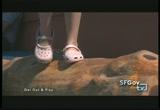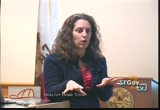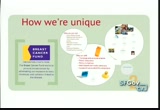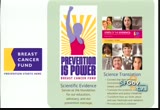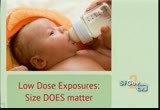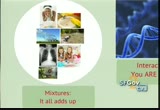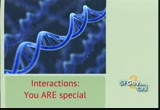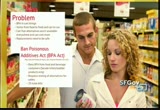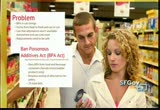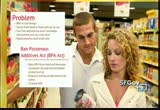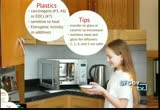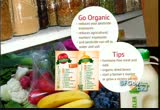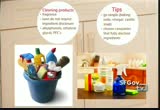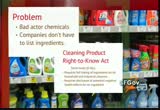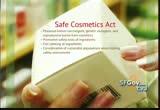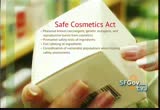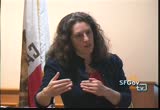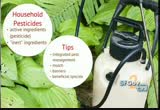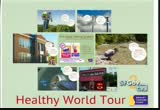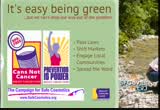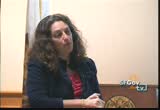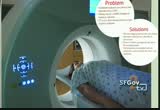tv [untitled] December 15, 2012 4:00pm-4:30pm PST
4:00 pm
>> thank you all for coming, i would like to really briefly introduce bonnie angle with the breast cancer fund, she is going to do a presentation for you on prevention, ways to preventolin ks of chemicals in breast cancer and i'll let her talk about the rest, bonnie, thank you for coming. >> alright. thank you all so much for being
4:01 pm
here today. i'm very excited to be able to give this presentation to you, unfortunately, i was expecting to have a co-presenter who had a minor accident and visited the emergency room this morning instead of visiting us, so we have plenty of folks from the breast cancer fund and other groups on hand to answer questions, but we are missing our policy geru unfortunately, i don't know how much this audience is familiar with it but we've also been meeting and talking about doing a study of exposures among women firefighters in particular, and so we have some members of that team talking about that here, sharl patton is back there, give a wave, and did rachel step out already? and rachel thought she was going to give a wave but she had to step out to go to another meeting, from the
4:02 pm
breast cancer fund, we have my two science leaders, [inaudible] and janet gray, so science questions galor, they can handle them all, policy questions, we'll have to deflect some of those to nancy for another time, so what i'm going to present today is what we call our healthy home and healthy world tours, i'll talk a little bit about who the breast cancer fund is and then we're going to walk through kind of the rooms in your home talking about tips for avoiding exposures that are linked to breast cancer and i will talk a little bit about the different chemicals, where they're found, things you can do to avoid them and also some policies, and then we'll kind of go beyond the home to talk about the kinds of exposures that might be not within our control in the house but elsewhere. and it looks like i have videos so that is good. so, the breast cancer fund is a
4:03 pm
national organization that works to prevent breast cancer by eliminating the environmental exposures linked o the disease, mostly we talk about chemicals and radiation that are linked to breast cancer, we are a little different from your breast cancer organizations out there, we often associate breast cancer with pink ribbons and we're about to see an onslaught of ribbons in our stores, we don't identify with pink because that's mostly associated with cures and treatments and we're on prevention, we're not affiliated with other breast cancer groups, there are all different breast cancer organize sashes that do their own agenda setting and we are an independent group that we have a board that helps us make decisions as an entity, we're not focused on a cure, we focus exclusively on prevention and environmental links to the disease, we don't fund
4:04 pm
individuals and there are some amazing organizations that do that work, they'll provide extra money for treatment or food and bill payment, that's not what we do, and we don't provide direct services like support groups or treatment or any of those things and there are other great organizations that do that work. we are an organization that translates and analyzes the science, i'll talk about that a little bit more in a minute, we work on public education, on policy initiatives, on web based and media advocacy, we have a lot of fun in that area so you should join us online and corporate accountability campaigns which i'll talk a little bit about later on in this presentation, we're really a community, so you can see pictures of different folks at different evens interacting and having a great time so we like to be hopeful that we can indeed prevent this disease and reduce the rates of breast
4:05 pm
cancer, and we have what we think is an amazing website that's full of all of the information that i'm going to present today and then some, so anything i talk about today, you can also find on our website which has rich information about the science, rich information about policy and ways that you can get involved, even by hiking in mount town this weekend and helping us raise some funds so we have some folks doing that in the audience as well, so as i said, we are a science-based organization, everything we do a rooted in a rich foundation in the science, and so for the past decade in fact, every couple of years, we produce a document called the state of the evidence, janet gray has been the primary author of the last two -- is it two or three, two editions plus the one we're working on right now which will update a lot of that on our
4:06 pm
website in particular, we're planning to unveil some exciting stuff in the next year, and with that, we try to connect the dots between the environmental exposures and breast cancer, we look at the peer reviewed literature, all of that rich scientific stuff and janet gray turns that into information that we can all read at various levels, and from there, we kind of translate it into presentations like this one, into policy needs and into tips on our website so we use that scientific foundation to do a lot of different things. i want to talk always about some of the themes that emerge pr the literature because that helps us understand why we're concerned about the particular chemicals which we are concerned, so some particular themes emerge in the literature that come up again and again across a number of different chemicals and the first of that
4:07 pm
is that early life exposures and exposures at other developmental periods are really important, so timing is as we're learning everything. another important concept is that low dose exposures matter, so we often talk about -- you'll hear like the dose makes the poison, we're finding out over time that that's not necessarily true in the sense that more dose means more bad health outcomes, it's looking like in some cases very minute doses have really major effects, and i want to talk about why that might be, so you see here a picture of some different periods of development that are of concern and these share something really important in common, and that is that these are times when the body's own hormones are orchestrating some complex and amazing things, during the
4:08 pm
prenatal period where with regard to the breast, you know, the basic structures are being laid down and that is guided by the body's own hormones or during puberty when breasts start to develop, we know that teenagers are like hormonally out of control, the hormones are doing some things there, pregnancy and lactation, and our body's own hormones work at these amazingly small amounts to make these big dramatic changes happen at these important periods of time, so it's not surprising perhaps that external chemicals na look to our body like hormones would have a somewhat notable effects at these same periods of development so that's an important concept that we're starting to see and chemicals that are endocrine disrupting compounds or hormone disrupters as you might hear them called are a big focus of the work we've been doing and of the
4:09 pm
data that's been emerging in the scientific literature in the last ten years so this is exciting stuff and we'll talk about specifics about that in a minute, another important theme that emerges that we were talking about our meeting earlier is that mixtures matter, it all adds upfinger so some of the chemicals i'm going to talk about you might be exposed to -- kids might be exposed in toys and in food products and in personal care products and all of these different things, so that you get an accumulation of one kind of chemical or a set of like related chemicals from a bunch of different sources, and those might act on the same path that other chemicals from other sources do, so you have this whole mixture of an 80 thousand chemical soup that we all live in and those all combine together to have effects. we also know that those
4:10 pm
different chemicals and exposures interact with our own characteristics as people, where we were born, where we grew up, the environmental and social stressors that we may or may not have encountered as children and your genes, your diet, our lifestyle, our physical activity, also shape, how vulnerable we might be to those chemical exposures so those are some key concepts to give a foundation for what we're going to get into now, and now we're going to get a little bit practical, so healthy homes, and here's our healthy, happy home, we're going to jump right on into the kitchen and we're going to jump into the cup board and talk about canned food, you might have heard of the chemical bpa, you'll see it on water bottles and baby bottles, and that means it does not have the
4:11 pm
chemical in it, bpa, what you might not know, it's not only in plastic but also in the lining of most food cans so you'll see this shiny layer if you open up a food can and also in a lot of the thermal receipt paper that you get, the kind that prints without making any noise, that can get on your skin, bpa is an endocrine disrupting compound and we sometimes call it the poster child edc because there's over 200 studies linking bpa to different health effects and we know a lot more about how it works than we do about some of the other chemicals that we're exploring and policies are kind of moving forward more rapidly too so if we could knock down bpa, it would set a precedent for other laws and market based changes that could have a big domino effect on our exposures, especially to endocrine disrupting compounds, you go
4:12 pm
back to standard you may have used in college, i did when i didn't have any money was to soak the beans, it's way cheaper, avoids canned food exposure, also to go with frozen or fresh vegetables if you can rather than cans, to choose stainless steel water bottles and other alternatives for baby bottles if you have young children and to change markets and to change laws because we know there are a lot of inequities that shapes who has access to healthy foods and fresh fruits,, we need to change some laws that these canned foods are safer, and more foods are available. we've gone into a can of corn, i don't know if you got that, we dove into this can of corn to talk about the bpa act, from
4:13 pm
representative ann marky from the house and senator from the senate, and this bans [inaudible] food and beverage containers, from infant and toddlers food, from everything, from adults, pregnant women, some important populations in there and requires the alternatives being considered for use is replacement be tested for safety in a significant way, and that is really important because we're finding that some of the possible replacements might look just like bpa in a lot of ways or might have some worker concerns that may not be linked to breast cancer but might be linked to other health concerns for workers like asthma and breathing concerns, it's very important, we've seen 20 state bills be introduced in the last couple of years which is a lot, that's almost half of the
4:14 pm
nation's states, so we're jumping out of bpa and popping over to the microwave, so related to bpa are other plastics, and so we encounter these plastics all over in our world and some plastics are carcinogens, number 3, and number 6 which are vinyl chloride and styrene and number 7 which can contain bpa but doesn't always, and there's also estrogenic activity, additives put into other plastics, so it's important to skip micro waiving in plastic, it leaks some of those chemicals into your food, i like to pop stuff into a ceramic bowl, put another ceramic bowl over it to create a lid and you're skipping the plastic. so, you can use stainless steel or glass for leftovers and
4:15 pm
overall, 1, 2, 4 and 5 are generally safer plastics but it's good to know that those additives even in those can lead to that so you want to be cognizant of that. going organic is another way to reduce exposures, to chemicals that you consume in the food but it has bigger effects because it's going to reduce the overall load of pesticides in our environment that workers and farmers are exposed to and make our way into our air and water so those are important reductions that go beyond our own home and can affect everybody's health. some tips there are to choose hormone-free meats and milks in particular, to go with organic dried beans or organic frozen fruits or vegetables, some of our colleagues have the dirty dozen of foods to almost always buy organic and the clean 15, which are foods that you can
4:16 pm
kind of skip the organic because they have a stronger protective, like a ban ban na which has such a big peel, keeps those pesticides out, so if you're working on an economy of scale, you know, go with organic with the ones that have the highest levels of pesticides. our website has a link to those tips so i can show you where that would be. and now we're going to pop into the living room and talk about flame retardants which are an important issue for any firefighters who are working in the field because it's those burns that are going to create exposures, so as folks in the home are thinking about that, once they found that frequent hand washing can reduce the actual levels of these flame retardants because we touch them, they get on our hands,
4:17 pm
they're in household dusts and make their way into our bodies, so washing them off our hands can reduce exposures, using a vak coupe with a hepa filter and a big move that could come down the pike is going down to legacy fabrics like wool and fabric that don't require the use of these mraim retardants at all and burn much more slowly, this's been some amazing videos that you can look at that you may have seen that show the legacy fabrics burning so much more slowly than the flame retardant treated ones, so that's some important information to have and makeshifts toward slower burning fabrics. moving into the bathroom, we're going to dive into the cleaning cabinet first, so a big shift here, cleaning products, this is a big one because it's easy
4:18 pm
to make safe choices if you know what's in your products, you know what you don't want to buy and you know what you do want to buy, with cleaning products, they don't have to tell you anything about what's being used in those products, even your cosmetics have more labeling than your cleaning products, so one of the major thins is moving towards companies that tell you what they use, particularly avoiding heavily fragrance products because that word fragrance, if you see that on any kind of label can contain dozens to hundreds of chemicals, some that could be likely to be endocrine disrupters, evelyn glycol, psb's, some tips here, and this is money saving too which is good because i've told you to buy organic and do all these other things, save some
4:19 pm
money by going with vinegar, baking soda, that's what i use in my home and you really can get your windows and your metals sparkling clean with vinegar, can get the grit off with baking soda, really effective things even in the laundry. we're going to jump right in and talk about some policy as we just covered cleaning products, they don't have the tell you what's in them, pass laws that require labeling of cleaning products, one that is are used in industrial settings like schools, my dad is a high school custodian, i want him to not be exposed to chemicals where he doesn't know where they are or in the fire houses, what are they using there? what are being used in hospitals at times or universities, all of these institutions can make big changes in overall exposures with industrial cleaners but we have to know what's in them and
4:20 pm
requiring disclosure of any potential health effects with cleaning ingredients so we know what the concerns are, there's a lot of overlap between cleaning products and personal care products, with personal care products, they are labeled which is excellent, except they can still have that sneaky little word fragrance which can still contain dozens to hundreds of chemicals, some of which may be endocrine disrupters like synthetic mosque, so wanting to avoid those and we're talking bath products, there's sometimes triclosan in tooth paste, we're talking stuff that men, kids, preteens are using, a whole gamete of stuff there, so going simpler, picking companies that really are telling you everything that's in your product so you can make informed choices, and also
4:21 pm
really being particularly cognizant with kid's products and we'll talk about that a little bit more in a second. so, there is this safe cosmetics act which works to phase out known carcinogens, genetic mute jens and reproductive toxins from cosmetics, right now, those are allowed to be in there, the u.s. has banned 11 things in cosmetics, also requiring premarket safety, tests of ingredients, full labeling including everything that's in fragrance and considering of vulnerable populations when deciding what's safe and what's not, so those are some important things that happen a lot. there are actually three different bills on personal care products in congress right now, there's the good bill, which does these things, there's the newt ra bill which
4:22 pm
keeps the status quo and then what's kind of a bad bill, and they all sound like they're good because they all sound like, you know, safety of chemicals in cosmetic, they all have those words but they don't really all do that so i think it's also important as you're thinking about these things to go to a reputable organization that you trust is going to give you real information and support the kinds of laws that they're supporting rather than one that's maybe a bill posed by the industry that, guess what, wants to be self-regulating. okay, so now we are moving to the driveway, and this is really interesting because we think about low emissions cars as being really important for maybe climate change but they also might be important for breast cancer because when fuel is burning and you guys are
4:23 pm
familiar with chemicals that, you know, come bust, lower emissions vehicle, one that's more efficient may reduce these pah's in our air and especially in urban areas reduce exposures to those compounds which is really pornts, so thinking about hybrid or electric, we're all lucky enough to take public transit and reduce those overall exposures or -- yeah? >> i believe so, is that true? yes, my science advisors, that's why they're here. >> [inaudible].
4:24 pm
>> yeah. there are a lot of carcinogens in diesel exhaust, yeah. >> [inaudible]. >> well, you're still seeing an oil that combusts, some of them we know burn more cleanly than others but if it's combusting, you end up with productions of combustion, it may not be better for pollution on the other side, depending on how clean the air burns and that's a theme we end up talking about a fair bit unfortunately is that bio doesn't always mean it's safer, it can, it can definitely mane we're reducing destruction of greenhouse gases but it can still make bad things outs of good ingredients if you know what i mean, another outdoor thing is to
4:25 pm
reduce your reliance on household pesticides so the active ingredients can be of concern, the pesticide itself, but most pesticide companies done label what are called the inert ingredient, that's the one that's not doing the pest killing per se, they can still really be bad chemicals, endocrine sdrukt tersest can be there, your baby crawls on your lawn, those exposures are out there, going with integrated pest management, beneficial species and doing these kinds of things in public parks and school yards ask things like that where, you know, you might be catching a larger catch man of land can be really important, so that is the healthy home tour and now we're going to go beyond the home into the healthy world tour and these are kind to have ways that the choices that we make
4:26 pm
as individuals or in our policies shape a healthier, safer world. so, we've talked very briefly about moving the markets along and i want to talk about that for just a moment more, so we have two major market-based campaigns with the breast cancer fund, the campaign with safe koz meats and cans, not cancer, they target the makers of products who are more agile than laws, it can take decades to pass a good law, we saw those in changes of health care, what year were we starting to talk about revising our health care policies, i think it was 93 and it was 2008 before there was passage of a law so it can take decades and dozens of years, but if we ask for safer products, the market can turn on a dime.
4:27 pm
in 2007-2008, everyone started talking about bpa in plastics, by 2009, bpa-free plastics were everywhere, so can, not cancer is getting bpa out of food cans and they chased a huge success this year when campbell's soup said we're going to take the bpa out, we're waiting for a timeline from them and waiting for them to replace bpa with something safer, taking that first step was huge, even more significant perhaps is the campaign for safe cosmetics which has been around for about 10 years saying that -- getting johnson & jn -- johnson saying we're going to get carcinogens first out of our baby products across the whole world and
4:28 pm
that's really significant because they found formaldehyde in baby's johnson shampoo a few years ago, they tested it a few yearser later and found that johnson & johnson has taken it out of their products in china and other countries but not in the united states, well, if you can do it in one country, why can't you do it in all of them, doesn't everybody deserve safer baby shampoo no matter where they live? that put a lot of pressure on them because the consumers said we don't want those things in our products and the change happened and now they have a plan with timelines and clear transparent goals to get those chemicals out of their products. it might be a little slower than we'd all like as consumers but it's moving in the right direction and getting one major company to move put a lot of pressure on those other
4:29 pm
companies if they want to maintain their credibility, so we're seeing safer shampoo products, we want to pass laws. >> radiation is the longest and best studied exposure link to breast cancer and what can we do about that, some radiation is naturally occurring, but we know that since 1980, radiation exposures for the average person have doubled and most of that is probably due to a 600 % increase in medical radiation, we're being exposed to a lot more radiation from medical tests, sometimes that's the only option, it's worth that added risk because
86 Views
IN COLLECTIONS
SFGTV2: San Francisco Government Television Television Archive
Television Archive  Television Archive News Search Service
Television Archive News Search Service 
Uploaded by TV Archive on

 Live Music Archive
Live Music Archive Librivox Free Audio
Librivox Free Audio Metropolitan Museum
Metropolitan Museum Cleveland Museum of Art
Cleveland Museum of Art Internet Arcade
Internet Arcade Console Living Room
Console Living Room Books to Borrow
Books to Borrow Open Library
Open Library TV News
TV News Understanding 9/11
Understanding 9/11